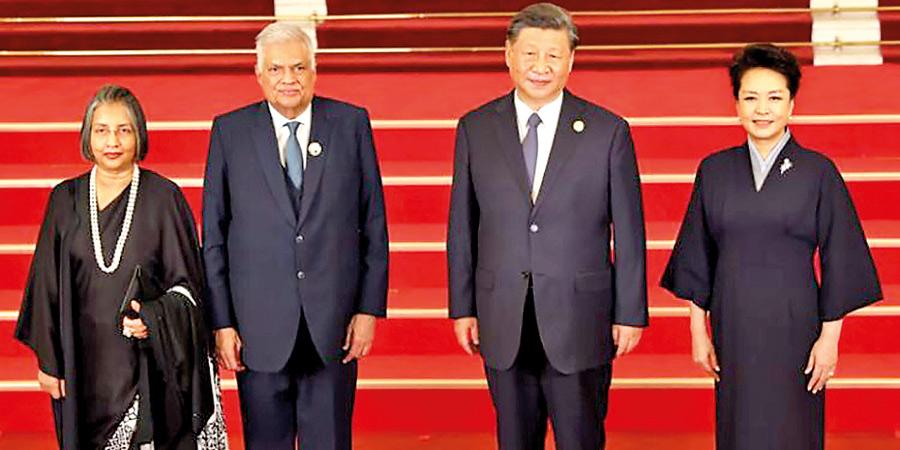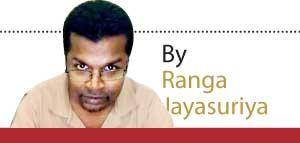Reply To:
Name - Reply Comment

President Ranil Wickremesinghe and Chinese President Xi Jinping at the 10th-anniversary summit of the BRI in Beijing
This week, leaders from 130 countries have gathered in the Chinese Capital, Beijing, for the 10th-anniversary summit of the Belt and Road Initiative (BRI), China’s signature infrastructure development plan.
development plan.
The summit dubbed the most important diplomatic event in China for this year, may still miss some of the headlines, as the news cycle is predisposed to the crisis in the Middle East.
However, the high-profile gathering in Beijing is a vote of confidence for President Xi Jinping’s trade mark initiative that has been decried, not necessarily on factual merit, by some Western policymakers and think tank pundits as a ‘debt trap’.
The event also provides an opportunity for Beijing to reaffirm its commitment to BRI, as it is facing headwinds in a slowing down of the Chinese economy and the rising default risk of a host of debtor nations.
Belt and Road
In 2013, barely months after his elevation to the dual role of the general secretary of the Chinese Communist Party and the President of China, Xi announced his vision of the 21st-century Silk Road during an official visit to Kazakhstan and later in an address to the Indonesian Parliament.
In his words, it was meant to ‘deepen the pattern of mutual benefit and win-win, take an active part in regional economic cooperation, speed up the interconnection and interconnection of infrastructure, …establish a new pattern of regional economic integration… and connect the Chinese dream with the wishes of a better life for the peoples in the neighbouring countries with the prospect of regional development so that Community awareness of fate in the neighbouring countries take root.”
Initially, the plan was named One Belt- One Road, but Chinese policymakers, who discerned a China-centric connotation, renamed the English nomenclature to the Belt and Road Initiative.
The central premise of the BRI was to build a network of infrastructure and transport corridors, trekking the path taken by the ancient Silk Road, via Central Asia, linking China with Europe. By the sea, a maritime Silk Road is building infrastructure in littoral states, linking Mainland China with Africa and the Middle East.
Being President Xi’s brainchild, BRI had the highest level of political patronage. China’s provincial governments, central and provincial SOEs and the private sector jumped the Silk Road caravan to go abroad. During the following decade, China splashed over $ 1 trillion in infrastructure loans across the world to build highways and railroads, power plants, airports and ports.
Belt and Road Initiative was not necessarily a unified project but an amalgam of old and new Chinese-funded projects brought under the jargon. Much of Sri Lankan projects, such as Hambantota Port and the Mattala Airport, were completed before the launch of the BRI in 2013.
Are best days behind?
Probably, with China facing its own economic worries, the best days of BRI may be behind.
The extent of Chinese financing has slowed down since the pandemic. For instance, according to the Chinese Loans to Africa (CLA) Database, managed by the Boston University Global Development Policy Centre, overall Chinese loans have declined to less than $ 2 billion in 2021 and 2022 from an all-time high of $ 28 billion in 2016.
In the meanwhile, default risk has hit all-time highs. According to the Aid data project, in 2010, less than 5 per cent of Beijing’s overseas lending portfolio supported borrower countries in distress, but that figure soared to 60 per cent by 2022.
China has reportedly provided US$ 240 billion in bail-out loans to 18 debtor countries, including Sri Lanka, to roll over their Chinese loan repayment.
Some pioneering countries of China’s infrastructure loan diplomacy, such as Pakistan, where the Pakistan Economic Corridor ( CPEC) was funded by a series of Chinese infrastructure loans totalling US$ 62 billion, are in deep fiscal distress, risking cascading defaults.
Sri Lanka itself is one of the earliest States to rely on Chinese loans for its infrastructure development. Colombo defaulted last year and has nearly 7.4 billion outstanding debt owed to China. The government last week announced it agreed with China’s EXIM bank to restructure 4.2 billion of outstanding debt.
China’s mounting domestic worries would dull the appetite for increased lending. The Chinese economy has so far failed to rebound since the lifting of COVID-related restrictions. Supply chain relocation due to American and EU nearshoring and friend shoring of factories is taking a toll on the Chinese economy.
US embargoes on advanced computer chips and critical high-end technology transfer would have long-term effects in slowing down Chinese Road to advance technology and constrain the market for Chinese machinery. New markets for Chinese technology were one of the key domestic economic drivers guiding the Belt and Road initiative.
Still, resilient and formidable
Yet, the temptation to dismiss the BRI as a debt trap or a failure is no less folly than the punting on the demise of China, which much of the same crowd indulged since way back from the Tiananmen in 1989.
China has proved extremely resilient, and there is no reason to believe Xi Jinping would let go of his signature foreign policy initiative, risking a huge reputational cost for him within the CPC ranks and China internationally.
Also, the factors that guided the BRI remain unchanged. The lateral pressure of China’s growth - primarily the search for new markets and sources of raw materials- remains intact. Add to that, Chinese businesses are moving abroad for lower labour costs and also to evade the pitfalls of a potential trade war between China and the US. Much of the Vietnamese industrial exports are tied to the China-centric supply chains. Also, the prestige associated with BRI is more important now than before. Geopolitics, though not the most important driver of BRI, would also be felt extra important now as China is in direct competition with the US.
China might be less inclined to splash funds as generously as before. That would only make much of the global South hungrier for infrastructure funding. A US$ 2-3 trillion annual gap exists in demand and supply of global infrastructure funding, which China tried to partially bridge by investing its excess capital.
After all, China’s growth forecasts of 4.5%, though may be low in China’s earlier meteoric performance, are still substantial for upper-middle-income countries of China’s gigantic size.
All that makes the BRI one of the most formidable drivers of economic growth, supply chain integration and infrastructure development for decades.
Sri Lanka’s place at BRI
President Ranil Wickremesinghe’s presence at the BRI summit shows pragmatism.
The motley group of participants also included global heavyweights like Russian President Vladimir Putin, who missed the G-20 summit in India and BRICS in South Africa, and our own, Ranil Wickremesinghe, Ethiopia’s prime minister Abiy Ahmed, and even a delegation from the Taliban. Hungary’s prime minister, Viktor Orban, led the highest-profile European delegation.
The Wickremesinghe administration has shifted from the overly China-dependent approach of its predecessors of the Rajapaksas. It has strived to diversify the country’s foreign relations and lobbied for a greater economic role by India and Japan. However, Sri Lanka’s relations with the West, the US, India and Japan do not need to be mutually exclusive of its relations with China.
Instead, Sri Lanka should diversify its relations, emphasizing economic development and creating a level playing field for all foreign actors to play a mutually beneficial role.
The US-led development initiative, India-Middle East Europe Corridor, considered a competitor for BRI, may offer more options for countries like Sri Lanka, which it should use.
Yet, Sri Lanka has already established itself as a lynchpin of the BRI, and any government that acts in the national interest should strive to build on those existing advantages.
Chinese financing helped ease a crippling infrastructure backlog in this country- had not Mahinda Rajapaksa’s squandered Chinese loans in vestige dynastic projects, those benefits would have been manifolds.
Going on a borrowing spree was easier as long as the Chinese were willing to write the cheque than reforming the country’s anti-business laws and combat corruption that discouraged genuine foreign investors. The Rajapaksas, who abused the loans to the extreme, showed no interest in reforming the latter.
Sri Lanka should approach the BRI not in search of loans but to form private-public partnerships, promote foreign direct investments and integrate itself with the global supply chains. That is where the real money is. That is also how to put the Chinese-funded infrastructure in places like Hambantota to economic use. Yet, Sri Lanka’s arcane laws and entrenched vested interests that foster a captive market for a few local wheeler dealers is a major turn-off for legitimate investors
The Wickremesinghe administration should tread on where Rajapaksa did not and make Sri Lanka a more welcoming destination to do business, reform anti-business, investment, land and labour laws, and put in place a mechanism to combat corruption. It should dismantle bureaucratic red tape, which goes hand in glove with kickbacks.
Rather than relying on the usual culprits in the bureaucracy who are a major factor in stalling reforms, the government should borrow from the best practices of successful states, establish dedicated agencies and hire private sector talent.
BRI should not be the only place Sri Lanka hedges its economic future. However, if Sri Lanka manages to recast itself as a more appetizing destination for investment, BRI could still be the most important source of growth for the Sri Lankan economy for decades to come.
Follow @Ranga Jayasuriya on X